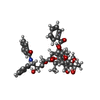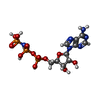+Search query
-Structure paper
| Title | Schizosaccharomyces pombe kinesin-5 switches direction using a steric blocking mechanism. |
|---|---|
| Journal, issue, pages | Proc Natl Acad Sci U S A, Vol. 113, Issue 47, Page E7483-E7489, Year 2016 |
| Publish date | Nov 22, 2016 |
 Authors Authors | Mishan Britto / Adeline Goulet / Syeda Rizvi / Ottilie von Loeffelholz / Carolyn A Moores / Robert A Cross /  |
| PubMed Abstract | Cut7, the sole kinesin-5 in Schizosaccharomyces pombe, is essential for mitosis. Like other yeast kinesin-5 motors, Cut7 can reverse its stepping direction, by mechanisms that are currently unclear. ...Cut7, the sole kinesin-5 in Schizosaccharomyces pombe, is essential for mitosis. Like other yeast kinesin-5 motors, Cut7 can reverse its stepping direction, by mechanisms that are currently unclear. Here we show that for full-length Cut7, the key determinant of stepping direction is the degree of motor crowding on the microtubule lattice, with greater crowding converting the motor from minus end-directed to plus end-directed stepping. To explain how high Cut7 occupancy causes this reversal, we postulate a simple proximity sensing mechanism that operates via steric blocking. We propose that the minus end-directed stepping action of Cut7 is selectively inhibited by collisions with neighbors under crowded conditions, whereas its plus end-directed action, being less space-hungry, is not. In support of this idea, we show that the direction of Cut7-driven microtubule sliding can be reversed by crowding it with non-Cut7 proteins. Thus, crowding by either dynein microtubule binding domain or Klp2, a kinesin-14, converts Cut7 from net minus end-directed to net plus end-directed stepping. Biochemical assays confirm that the Cut7 N terminus increases Cut7 occupancy by binding directly to microtubules. Direct observation by cryoEM reveals that this occupancy-enhancing N-terminal domain is partially ordered. Overall, our data point to a steric blocking mechanism for directional reversal through which collisions of Cut7 motor domains with their neighbors inhibit their minus end-directed stepping action, but not their plus end-directed stepping action. Our model can potentially reconcile a number of previous, apparently conflicting, observations and proposals for the reversal mechanism of yeast kinesins-5. |
 External links External links |  Proc Natl Acad Sci U S A / Proc Natl Acad Sci U S A /  PubMed:27834216 / PubMed:27834216 /  PubMed Central PubMed Central |
| Methods | EM (single particle) |
| Resolution | 9.3 Å |
| Structure data | EMDB-3445: cryo-electron microscopy reconstruction of microtubule-bound S.pombe kinesin-5 motor domain in the AMPPNP state |
| Chemicals |  ChemComp-MG:  ChemComp-GTP:  ChemComp-GDP:  ChemComp-TA1:  ChemComp-ANP: |
| Source |
|
 Keywords Keywords | MOTOR PROTEIN / microtubule-bound S.pombe kinesin-5 / motor domain / AMPPNP bound state / MODELLER 9.10 2013-08 complex |
 Movie
Movie Controller
Controller Structure viewers
Structure viewers About Yorodumi Papers
About Yorodumi Papers











